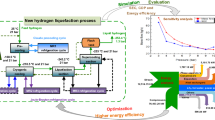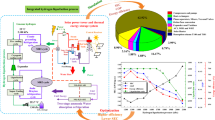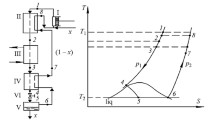Abstract
The key technologies of liquefied hydrogen have been developing rapidly due to its prospective energy exchange effectiveness, zero emissions, and long distance and economic transportation. However, hydrogen liquefaction is one of the most energy-intensive industrial processes. A small reduction in energy consumption and an improvement in efficiency may decrease the operating cost of the entire process. In this paper, the detailed progress of design and optimization for hydrogen liquefaction in recent years are summarized. Then, based on the refrigeration cycles, the hydrogen liquefaction processes are divided into two parts, namely precooled liquefaction process and cascade liquefaction process. Among the existing technologies, the SEC of most hydrogen liquefaction processes is limited in the range of 5–8kWh/kgLH2 (LH2: liquid hydrogen). The exergy efficiencies of processes are around 40% to 60%. Finally, several future improvements for hydrogen liquefaction process design and optimization are proposed. The mixed refrigerants (MRs) as the working fluids of the process and the combination of the traditional hydrogen liquefaction process with the renewable energy technology will be the great prospects for development in near future.
Similar content being viewed by others
References
Turner J A. Sustainable hydrogen production. Science, 2004, 305 (5686): 972–974
Cardella U, Decker L, Klein H. Roadmap to economically viable hydrogen liquefaction. International Journal of Hydrogen Energy, 2017, 42(19): 13329–13338
LBST, Hydrogen Refueling Station Worldwide. 2019-06-18, available at netinform.de website
Valenti G. Hydrogen liquefaction and liquid hydrogen storage. In: Gupta R B, Basile A, Nejat T. Compendium of Hydrogen Energy. Woodhead Publishing, 2016, 27–51
Acar C, Dincer I. Hydrogen energy. In: Dincer I, eds. Comprehensive Energy Systems, Elsevier, 2018, 1: 568–605
Ball M, Wietschel M. The Hydrogen Economy: Opportunities and Challenges. Cambridge: Cambridge University Press, 2009
Li M, Bai Y F, Zhang C Z, Song Y, Jiang S, Grouset D, Zhang M. Review on the research of hydrogen storage system fast refueling in fuel cell vehicle. International Journal of Hydrogen Energy, 2019, 44(21): 10677–10693
Nash D, Aklil D, Johnson E, Gazey R, Ortisi V. Hydrogen storage: compressed gas. Comprehensive Renewable Energy, 2012, 4: 131–155
Dewar J. Liquid hydrogen. Science, 1900, 11(278): 641–651
Krasae-in S, Stang J H, Neksa P. Development of large-scale hydrogen liquefaction processes from 1898 to 2009. International Journal of Hydrogen Energy, 2010, 35(10): 4524–4533
Drnevich R. Hydrogen delivery: liquefaction and compression. In: Strategic initiatives for Hydrogen Delivery Workshop, Tonawanda, NY, USA, 2003
Bracha M, Lorenz G, Patzelt A, Wanner M. Large-scale hydrogen liquefaction in Germany. International Journal of Hydrogen Energy, 1994, 19(1): 53–59
Shimko M, Gardiner M. Innovative hydrogen liquefaction cycle. FY 2008 Annual Progress Report, DOE Hydrogen Program, 2008
Tang L. Hydrogen liquefaction process design and system simulation based on liquid nitrogen precooling. Dissertation for the Master Degree. Hangzhou: Zhejiang University, 2011, 23–32
Yuksel Y E, Ozturk M, Dincer I. Analysis and assessment of a novel hydrogen liquefaction process. International Journal of Hydrogen Energy, 2017, 42(16): 11429–11438
Krasae-in S, Stang J H, Neksa P. Simulation on a proposed large-scale liquid hydrogen plant using a multi-component refrigerant refrigeration system. International Journal of Hydrogen Energy, 2010, 35(22): 12531–12544
Ansarinasab H, Mehrpooya M, Mohammadi A. Advanced exergy and exergoeconomic analyses of a hydrogen liquefaction plant equipped with mixed refrigerant system. Journal of Cleaner Production, 2017, 144: 248–259
Stetson N T, Olson G L, Bowman R C Jr. Overview of hydrogen storage, transportation, handling and distribution. In: Sherif S A, Goswami D Y, Stefanakos E K. et al. Handbook of Hydrogen Energy. CRC Press, 2014: 567–592
Vander Arend P. Large-scale liquid hydrogen production. Chemical Engineering Progress, 1961, 57(10): 62–67
Hutchinson H L. A kinetics study of the para-ortho shift of hydrogen. Dissertation for the Master Degree. Colorado: University of Colorado, 1964
Silvera I F. The solid molecular hydrogens in the condensed phase: fundamentals and static properties. Reviews of Modern Physics, 1980, 52(2): 393–452
Sullivan N, Zhou D, Edwards C. Precise and efficient in situ orthopara-hydrogen converter. Cryogenics, 1990, 30(8): 734–735
Barron R F. Liquefaction cycles for cryogens. In: Timmerhaus K D. Advances in Cryogenic Engineering. Boston: Springer, 1972, 20–36
Aasadnia M, Mehrpooya M. Large-scale liquid hydrogen production methods and approaches: a review. Applied Energy, 2018, 212: 57–83
Nandi T K, Sarangi S. Performance and optimization of hydrogen liquefaction cycles. International Journal of Hydrogen Energy, 1993, 18(2): 131–139
Peschka W. Liquid Hydrogen: Fuel of the Future. Springer Science & Business Media, 2012
Yin L, Ju Y L. Comparison and analysis of two nitrogen expansion cycles for BOG Re-liquefaction systems for small LNG ships. Energy, 2019, 172: 769–776
Baker C R, Shaner R L. A study of the efficiency of hydrogen liquefaction. International Journal of Hydrogen Energy, 1978, 3(3): 321–334
Mitsugi Ch, Harumi A, Kenzo F W E N E T. Japanese hydrogen program. International Journal of Hydrogen Energy, 1998, 23(3): 159–165
Kuz’menko I F, Morkovkin I M, Gurov E I. Concept of building medium-capacity hydrogen liquefiers with helium refrigeration cycle. Chemical and Petroleum Engineering, 2004, 40(1/2): 94–98
Garceau N M, Baik J H, Lim C M, Kim S Y, Oh I H, Karng S W. Development of a small-scale hydrogen liquefaction system. International Journal of Hydrogen Energy, 2015, 40(35): 11872–11878
Hammad A, Dincer I. Analysis and assessment of an advanced hydrogen liquefaction system. International Journal of Hydrogen Energy, 2018, 43(2): 1139–1151
Staats W L. Analysis ofa supercritical hydrogen liquefaction cycle. Dissertation for the Master Degree. Massachusetts: Massachusetts Institute of Technology, 2008
Matsuda H, Nagami M. Study of large hydrogen liquefaction process. Hydrogen Energy, 1997, 8: 175–175
Quack H. Conceptual design of a high efficiency large capacity hydrogen liquefier. AIP Conference Proceedings, 2002, 613: 255–263
Valenti G, Macchi E. Proposal of an innovative, high-efficiency, large-scale hydrogen liquefier. International Journal of Hydrogen Energy, 2008, 33(12): 3116–3121
Stang J, Neksa P, Brendeng E. On the design of an efficient hydrogen liquefaction process. In: 16th World Hydrogen Energy Conference 2006 (WHEC 2006), Lyon, France, 2006: 1–6
Krasae-in S. Optimal operation of a large-scale liquid hydrogen plant utilizing mixed fluid refrigeration system. International Journal of Hydrogen Energy, 2014, 39(13): 7015–7029
Sadaghiani M S, Mehrpooya M. Introducing and energy analysis of a novel cryogenic hydrogen liquefaction process configuration. International Journal of Hydrogen Energy, 2017, 42(9): 6033–6050
Asadnia M, Mehrpooya M. A novel hydrogen liquefaction process configuration with combined mixed refrigerant systems. International Journal of Hydrogen Energy, 2017, 42(23): 15564–15585
Cardella U, Decker L, Sundberg J, Klein H. Process optimization for large-scale hydrogen liquefaction. International Journal of Hydrogen Energy, 2017, 42(17): 12339–12354
Kuendig A, Loehlein K, Kramer G, Huijsmans J. Large scale hydrogen liquefaction in combination with LNG re-gasification. In: 16th World Hydrogen Energy Conference 2006 (WHEC 2006), Lyon, France, 2006: 3326–3333
Kramer G J, Huijsmans J, Austgen D. Clean and green hydrogen. In: 16th World Hydrogen Energy Conference 2006 (WHEC 2006), Lyon, France, 2006: 3317–3325
Ansarinasab H, Mehrpooya M, Sadeghzadeh M. An exergy-based investigation on hydrogen liquefaction plant-exergy, exergoeconomic, and exergoenvironmental analyses. Journal of Cleaner Production, 2019, 210: 530–541
Aasadnia M, Mehrpooya M. Conceptual design and analysis of a novel process for hydrogen liquefaction assisted by absorption precooling system. Journal of Cleaner Production, 2018, 205: 565–588
Muradov N Z, Veziroglu T N. “Green” path from fossil-based to hydrogen economy: an overview of carbon-neutral technologies. International Journal of Hydrogen Energy, 2008, 33(23): 6804–6839
Yilmaz C, Kaska O. Performance analysis and optimization of a hydrogen liquefaction system assisted by geothermal absorption precooling refrigeration cycle. International Journal of Hydrogen Energy, 2018, 43(44): 20203–20213
Yilmaz C. Optimum energy evaluation and life cycle cost assessment of a hydrogen liquefaction system assisted by geothermal energy. International Journal of Hydrogen Energy, 2019, https://doi.org/10.1016/j.ijhydene.2019.03.105
Yuksel Y E, Ozturk M, Dincer I. Energetic and exergetic assessments of a novel solar power tower based multigeneration system with hydrogen production and liquefaction. International Journal of Hydrogen Energy, 2019, 44(26): 13071–13084
Zhang H, Gimaev R, Kovalev B, Kamilov K, Zverev V, Tishin A. Review on the materials and devices for magnetic refrigeration in the temperature range of nitrogen and hydrogen liquefaction. Physica B, Condensed Matter, 2019, 558: 65–73
He T B, Karimi I A, Ju Y L. Review on the design and optimization of natural gas liquefaction processes for onshore and offshore applications. Chemical Engineering Research & Design, 2018, 132: 89–114
Kwak D H, Heo J H, Park S H, Seo S J, Kim J K. Energy-efficient design and optimization of boil-off gas (BOG) re-liquefaction process for liquefied natural gas (LNG)-fuelled ship. Energy, 2018, 148: 915–929
Author information
Authors and Affiliations
Corresponding author
Rights and permissions
About this article
Cite this article
Yin, L., Ju, Y. Review on the design and optimization of hydrogen liquefaction processes. Front. Energy 14, 530–544 (2020). https://doi.org/10.1007/s11708-019-0657-4
Received:
Accepted:
Published:
Issue Date:
DOI: https://doi.org/10.1007/s11708-019-0657-4




